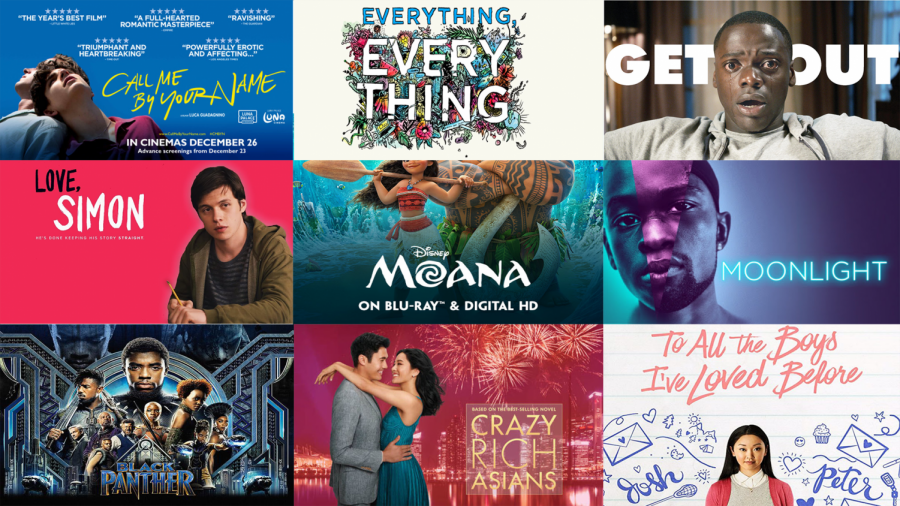A Necessity Called Representation
A deep look into the level of representation in Hollywood and why it matters
December 7, 2018
When was the first time you saw yourself represented by a character in mainstream entertainment? Did you sit yourself down on the carpet close enough to the screen to hear the slight buzzing of the pixels and see a person just like you? Did you see a person that made you be proud of who you are?
I can’t recall experiencing this because, throughout my childhood, I saw myself represented every day, but many people tell a far different story.
I still do have the privilege of seeing myself represented in entertainment every single day. It might be hard for people like me to understand the significance of representation in movies or TV shows, and for a long time, I fell into that group.
I grew up seeing white men dominate the big screens as the movie-saving hero. Those movies always made me feel empowered; they left me inspired as the credits engulfed the black screen and the theater lit up. In modern America, a lack of representation should be considered a travesty. Movies sewing stories of the real world, unfortunately, lack real-world diversity more times than not, and the importance of such diversity cannot be underestimated.
People growing up in a world that does not reflect their being generates unbelievable amounts of damage. Without the chance to vicariously live through a diverse population of stories and experiences, how can people understand the everyday strife of people of color, various sexual orientations, and/or gender identities? A former professor at the University of Massachusetts, Michael Morgan, says, “Stories affect how we live our lives, how we see other people, how we think about ourselves.”
A fascinating field of this study is known as “symbolic annihilation,” which essentially states that a lack of representation of a certain person makes that person feel unimportant, obviously resulting in severe self-esteem and confidence issues.
Similarly, a certain type of representation that I have come to call “mock representation” incites just as much damage as no representation at all. Mock representation is seen when a movie or TV show points to a painfully manufactured archetype as their source of diversity — for example, the sassy black girl sidekick, the nerdy, shy Asian girl, or the flamboyant gay best friend. People who might in part fit these descriptions are completely valid, but there is so much more to everyone than those pathetically minimal characteristics. These particular stereotypes embody cringe-worthily one-dimensional figures which force some people to feel like these descriptions are who they have to be. Being exposed to such molds, at young ages especially, create an illusion that this all some people are meant to be.
Morgan also said, “Over and over and over, week after week, month after month, year after year, it sends a very clear message, not only to members of those groups, but to members of other groups, as well … the message is: You’re invisible. You don’t count. There’s something wrong with me.”
When the conversation turns to representation, three major motion picture films come to mind for me, at least: Black Panther, Love, Simon, and Crazy Rich Asians. Three blockbusters that, internationally, raked in over $1.2 billion, $66.3 million, and $236.7 million, respectively.
Black Panther, unsurprisingly, set 17 records, including the most-tweeted-about movie ever.
There is something to be said about this. Black Panther is one of the only Disney films to be so magnificently colorful. From the glorious attire fit for African royalty and the contagious charisma that Chadwick Boseman and Michael B. Jordan endlessly exude to the surprising yet impressive political topics that the movie embraces head on, Black Panther is a well-seasoned replacement of the bland dish we are far too frequently served by the Hollywood elites.
Exactly one month after the debut of Black Panther, another powerful movie hit theaters. Love, Simon caused tears around the nation and inspired a multitude of people to come out to their own friends and family, an action requiring more bravery than most people muster up in a single decade of their lives. Love, Simon highlights an intricate journey many, if not all, LGBT youth find themselves navigating at some point; a journey from realization to self-acceptance, and finally to coming out.
Movies like Love, Simon are so inexcusably important that one wonders why there are so little of them. For as long as I can recall, movie after movie has focused on heterosexual love. Love, Simon could not have come any sooner; anyone with common sense can see the hope and inspiration it gives to people who identify as LGBT and even to straight people, galvanizing a new generation of shining inclusiveness and acceptance.
Freelance writer Kyle Clark says it best: “Had a film like this been out when I was younger, maybe I would’ve felt more comfortable with myself due to the normalization of homosexuality.”
Five months later, yet another monumental movie was released.
Crazy Rich Asians is a movie the likes of which Hollywood have never seen before. The first movie to have an all-Asian cast in 25 years, Crazy Rich Asians also emerged as the highest grossing Romantic Comedy in the U.S in the last decade. This record, among others, is not what makes Crazy Rich Asians such an important movie, however; it is the sheer magnitude of Asian culture fit into one movie; the depiction of Asian men, women, and children of all ages doing jobs and pursuing hobbies of all kinds. The shallow characterization of the shy, nerdy Asian has been buried, and Crazy Rich Asians holds the shovel.
At this point, it is clear that colorfully diverse movies matter. But what do the audiences have to say?
According to the 2018 Hollywood Diversity Report, the top 149 movies featuring a white lead role, made a global box office median value of $62.3 million. Albeit a respectable amount of money, it is nothing compared to the global box office median made by movies featuring minority leads. The top 17 films featuring black leads produce a median of $55 million, the top 3 movies featuring lead actors of Asian descent make up $140.1 million, and the just the top 3 movies featuring a lead role of mixed race accounted for $217 million.
People like representation and diversity. The numbers speak for themselves.
With movies like Black Panther, Love, Simon, and Crazy Rich Asians, it might be easy for some people to say, “What are you complaining about? We have representation!”
I respectfully disagree.
Only 33% of the 1,100 movies and 48,757 characters studied in last year’s edition of USC’s Annenberg Inclusion Initiative’s annual study had a female lead role and talking female roles clock in at a pitiful 31.4%.
This brings to mind another injustice, specifically in the matter of representation of the LGBT community. Many people underestimate the meaning of LGBT characters who are portrayed as more than just that. What we should see more of, is characters in a story, who might pursue a love interest of the same sex, but that’s it. There does not always have to be a monumental coming out, or a pair of homophobic parents for the audience to hate. Sometimes it’s nice to see LGBT love stories that don’t center around homophobia, but center around love.
The critics, researchers, and audience are in agreement, but what do students of North Allegheny think?

The truth is that everyone deserves to see themselves reflected in influential, powerful, individualistic characters; everyone deserves the feeling of adrenaline as they exit the theater; everyone deserves the “If they can do it, why can’t I?” moment after watching a character that reflects themselves.
Representation is priceless.
And its results are endless.













